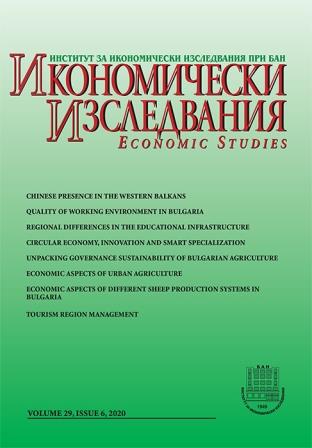Economic Aspects of Different Sheep Production Systems in Bulgaria
Economic Aspects of Different Sheep Production Systems in Bulgaria
Author(s): Konstantin StankovSubject(s): Economy, Agriculture
Published by: Институт за икономически изследвания при Българска академия на науките
Keywords: sheep farming; milk; meat; wool; income; costs; profit; profitability
Summary/Abstract: Bulgarian sheep husbandry is the most traditional occupation that helped people earning their living for thousands of years. It has laid the foundations of the crafts and industry in our country. The manuscript presents information on the measures taken by the European Parliament (EP) for the sheep husbandry development during the next decades. Detailed data on the state and development of sheep farming in Bulgaria for a period of 118 years are presented and recommendations are made in line with the theses from the EP resolution. The results of the study show that the sheep population in EC countries are declining by 2% annually. Compared to the 1980s, their number has decreased by 25 million. Sheep meat consumption in the EC has declined by 3.5 kg at 2 kg per capita. For the same period, a drastic decrease in the number of sheep and their products has occurred in Bulgaria. Compared to the 1980s, the number of sheep in the country was reduced by over 9 million. The total sheep meat production has decreased about 23 times, and that of sheep milk – 4.5 times. Consumption of sheep meat in Bulgaria decreased to 1.5 kg per capita. Sheep wool, which before the transition was a leading source of income, was removed from the group of main products and included in the by-products group.From this part, it may be concluded that Bulgaria has a substantial natural resource of pastures and cultivable land for the development of a significantly larger scale of livestock husbandry as it had been at all stages of country's development. Raising animals on pastures could be a good source of revenue for people, providing higher added value and contributing to the revival of rural areas.The next part of the paper presents information on the main economic indicators of dairy ewes and local autochthonous sheep breeds. The influence of the farming system on the ultimate economic results in the farms: extensive in the mountainous areas; semi-intensive in semi-mountainous areas and intensive for the plain regions of the country was studied. For this purpose, three of the most typical Bulgarian sheep farms with 300 ewes, 60 replacement female yearling sheep and 7-8 rams were selected. All natural and economic indicators were reported per one ewe.Sheep subject of the study was from the Bulgarian Dairy Synthetic Population, which is the most typical representative of Bulgarian dairy sheep husbandry (65.9% of the population). The second breed is the indigenous Srednorodopska sheep – a most typical representative of autochthonous sheep farming with a relative share of 26.59%. Both breeds account for 90% of the national sheep population.The results from the investigation of the three flocks reared under different geographic and technological conditions evidence a relatively poor economic effect. Sheep reared indoor all year round whose feeding was balanced, showed better economic performance.The sheep breeds and farming systems, subject of the present study provide sufficient objective information for the present state of Bulgarian sheep husbandry. The results allowed making important conclusions on the future development of the branch and proposing directions for its successful development.
Journal: Икономически изследвания
- Issue Year: 2020
- Issue No: 6
- Page Range: 155-170
- Page Count: 16
- Language: English

